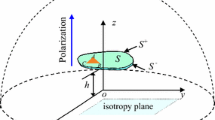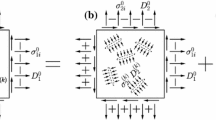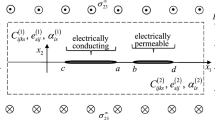Abstract
The non-zero traction condition is introduced in piezoelectric crack problems with the unknown Coulombic traction acting on the crack surfaces. An analytical solution under this condition is obtained by means of the generalized Stroh formalism and by accounting for the permittivity of medium inside the crack gap. As the crack in such materials can be thought of as a low-capacitance medium carrying a potential drop, the Coulombic traction always pulls the two opposite surfaces of the crack together. It is proved that under relatively larger mechanical loading and relatively smaller electrical field, the Coulombic traction may be negligible and the previous investigations under the traction-free crack condition may be accepted in a tolerant way, otherwise the Coulombic traction may lead to some erroneous results with over 10% relative errors. It is also shown that, unlike the traction-free crack condition, the applied electric field does change the Mode I stress intensity factor (SIF) for a central crack in an infinite plane piezoelectric material, and in this way may significantly influence piezoelectric fracture. It is also concluded that the variable tendencies of the normalized SIF and the ERR against the applied electric field depend on the mechanical loading levels. This load-dependence feature may lead to a transformation of the normalized SIF and the ERR from an even functional dependence to an odd functional dependence on the applied electric field.
Similar content being viewed by others
References
Zhang T.Y., Zhao M.H. and Tong P. (2001). Fracture piezoelectric ceramics. Adv. Appl. Mech. 38: 147–289
Chen Y.H. and Lu T.J. (2003). Cracks and fracture in piezoelectrics. Adv. Appl. Mech. 39: 121–215
Zhang T.Y. and Gao C.F. (2004). Fracture behaviors of piezoelectric materials. Theo. Appl. Fract. Mech. 41: 339–379
Chen Y.H. and Hasebe N. (2005). Current understandings on fracture behaviors of ferroelectric/piezoelectric materials. J. Intel. Mater. Syst. Struct. 16: 673–687
Suo Z., Kuo C.M., Barnett D.M. and Willis J.R. (1992). Fracture mechanics of piezoelectric ceramics. J. Mech. Phys. Solids 40: 739–765
Tobin A.C. and Pak Y.E. (1993). Effect of electric fields on fracture behavior of PZT ceramics. In: Proceedings of SPIE, Smart Structures and Materials 1916: 78–86
Park S.B. and Sun C.T. (1995). Fracture criteria for piezoelectric ceramics. J. Am. Ceram. Soc. 78: 1475–1480
Park S.B. and Sun C.T. (1995). Effect of electric fields on fracture of piezoelectric ceramics. Int. J. Fract. 70: 203–216
Heyer V., Schneider G.A., Balke H., Drescher J. and Bahr H.A. (1998). A fracture criterion for conducting cracks in homogeneously poled piezoelectric PZT-PIC151 ceramics. Acta Mater. 46: 6615–6622
Schneider G.A. and Heyer V. (1999). Influence of the electric field on Vickers indentation crack growth in BaTiO3. J. Eur. Ceram. Soc. 19: 1299–1306
Shindo Y., Ozawa E. and Nowacki J.P. (1990). Singular stress and electric fields of a cracked piezoelectric strip. Appl. Electromag. Mater. 1: 77–87
Shindo Y. and Ozawa E. (1990). Dynamic analysis of a cracked piezoelectric material. In: Hsieh, R.K.T. (eds) Mechanical Modeling of New Electromagnetic Materials, Elsevier, Amsterdam
Shindo Y., Katsura H. and Yan W. (1996). Dynamic stress intensity factor of a cracked dielectric medium in a uniform electric field. Acta Mech. 117: 1–10
Shindo Y., Narita F. and Tanaka K. (1996). Electroelastic intensification near anti-plane shear crack in orthotropic piezoelectric ceramic strip. Theo. Appl. Fract. Mech. 25: 65–71
Shindo Y., Tanaka K. and Narita F. (1997). Singular stress and electric fields of a piezoelectric ceramic strip under longitudinal shear. Acta Mech. 120: 31–45
Shindo Y., Domon W. and Narita F. (1997). Bending of a symmetric piezothermoelastic laminated plate with a through crack. Arch. Appl. Mech. 49: 403–412
Shindo Y., Watanabe K. and Narita F. (2000). Electroelastic analysis of a piezoelectric ceramic strip with a central crack. Int. J. Eng. Sci. 38: 1–19
Parton V.Z. (1976). Fracture mechanics of piezoelectric materials. Acta Astro. 3: 671–683
Deeg, W.F.: The analysis of dislocation, cracks, and inclusion problems in piezoelectric solids. PhD These, Stanford University, Stanford (1980)
Parton V.Z. and Kudryavtsev B.A. (1988). Electromagnetoelasticity. Gordon and Breach Science Publishers, New York
Hao T.H. and Shen Z.Y. (1994). A new electric boundary condition of electric fracture mechanics and its application. Eng. Fract. Mech. 47: 793–802
Dunn M. (1994). The effects of crack face boundary conditions on the fracture mechanics of piezoelectric solids. Eng. Fract. Mech. 48: 25–39
Sosa H. and Khutoryansky N. (1996). New development concerning piezoelectric materials with defects. Int. J. Solids Struct. 33: 3399–3414
Chung M.Y. and Ting T.C.T. (1996). Piezoelectric sold with an elliptic inclusion or hole. Int. J. Solids Struct. 33: 3343–3361
Gao H., Zhang T.Y. and Tong P. (1997). Local and Global energy release rates for an electrically yielded crack in a piezoelectric ceramic, J. Mech. Phys. Solids 45: 491–510
Chen Y.H. and Han J.J. (1999). Macrocrack-microcrack interaction in piezoelectric materials. Part I. Basic formulations and J-analysis. ASME J. Appl. Mech. 66: 514–521
Chen Y.H. and Han J.J. (1999). Macrocrack-microcrack interaction in piezoelectric materials, Part II. Numerical results and Discussions. ASME J. Appl. Mech. 66: 522–527
Fulton C.C. and Gao H. (2001). Effect of local polarization switching on piezoelectric fracture. J. Mech. Phys. Solids 49: 927–952
Xu X.L. and Rajapakse R.K.N.D. (1999). Analytical solution for an arbitrarily oriented void/crack and fracture of piezoceramics. Acta Mater. 47: 1735–1747
Xu X.L. and Rajapakse R.K.N.D. (2001). On a plane crack in piezoelectric solids. Int. J. Solids Struct. 38: 7643–7658
McMeeking R.M. (1990). A J-integral for the analysis of electrically induced mechanical stress at cracks in elastic dielectrics. Int. J. Eng. Sci. 28: 605–613
McMeeking R.M. (1999). Crack tip energy release rate for a piezoelectric compact tension specimen. Eng. Fract. Mech. 64: 217–244
McMeeking R.M. (2001). Towards a fracture mechanics for brittle piezoelectric and dielectric materials. Int. J. Fract. 108: 25–41
Landis C.M. (2004). Energetically consistent boundary conditions for electromechanical fracture. Int. J. Solids Struct. 41: 6291–6315
McMeeking R.M. (2004). The energy release rate for a Griffith crack in a piezoelectric material. Eng. Fract. Mech. 71: 1149–1163
Gruebner O., Kamlah M. and Munz D. (2003). Finite element analysis of cracks in piezoelectrics taking into account the permittivity of the crack medium. Eng. Fract. Mech. 70: 1399–1413
Ou Z.C. and Chen Y.H. (2003). Discussion of the crack face electric boundary condition in piezoelectric fracture mechanics. Int. J. Fract. 123: L151–L155
Ou Z.C. and Chen Y.H. (2005). On approach of crack tip energy release rate for a semi-permeable crack when electromechanical loads become very large. Int. J. Fract. 133: 89–105
Haug A. and McMeeking R.M. (2001). Energy release rate for a crack with extrinsic surface charge in a piezoelectric compact tension specimen. Solid Mech. Appl. 84: 349–360
Riceour A., Enderlein M. and Kuna M. (2005). Calculation of the J-integral for limited permeable cracks in piezoelectrics. Arch. Appl. Mech. 74: 536–549
Stevanović Hedrih K. and Perić L. (2003). Methods for solving problems of electroelastic piezoelectric bodies with defect applying spatial anaysis in MATLAM, FACTA UNIVERSITATIS Series: Mechanics. Autom. Control Robot. 3: 511–532
Hedrih Stevanović K. and Perić Lj. (2003). Application of function of complex variable and MATLAB to analysis of piezoelectric body stress and strain state with crack. Int. J Nonlinear Sci. Numer. Simul. 4: 339–360
Wippler K., Ricoeur A. and Kuna M. (2004). Towards the computation of electrically permeable cracks in piezoelectrics. Eng. Frac. Mech. 71: 2567–2587
Munir, H.N., Brussel, M.K.: Electricity and magnetism. University of Illinois at Urbana-Champaign, New York (1985)
England A.H. (1965). A crack between dissimilar media. ASME J. Appl. Mech. 32: 400–402
Fu R. and Zhang T.Y. (2000). Effect of an applied electric field on the fracture toughness of lead zirconate titanate ceramics. J. Am. Ceram. Soc. 83: 1215–1218
Sun C.T. and Park S.B. (2000). Measuring fracture toughness of piezoelectrics by Vickers indentation under the influence of electric fields. Ferroelectrics 248: 79–95
Ting T.C.T. (1986). Explicit solution and invariance of the singularities at an interface crack in anisotropic composites. Int. J. Solids Struct. 22: 965–983
Ting T.C.T. (1990). Interface crack in anisotropic bimaterials. J. Mech. Phys. Solids 38: 505–513
Muskhelishvili N.I. (1953). Some basic problems of mathematical theory of elasticity. Noordhoof, Leyden
Author information
Authors and Affiliations
Corresponding author
Rights and permissions
About this article
Cite this article
Li, Q., Chen, Y.H. Why traction-free? Piezoelectric crack and Coulombic traction. Arch Appl Mech 78, 559–573 (2008). https://doi.org/10.1007/s00419-007-0180-7
Received:
Accepted:
Published:
Issue Date:
DOI: https://doi.org/10.1007/s00419-007-0180-7




